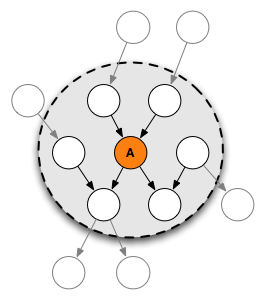
Markov blanket
Encyclopedia

Machine learning
Machine learning, a branch of artificial intelligence, is a scientific discipline concerned with the design and development of algorithms that allow computers to evolve behaviors based on empirical data, such as from sensor data or databases...
, the Markov blanket for a node
Vertex (graph theory)
In graph theory, a vertex or node is the fundamental unit out of which graphs are formed: an undirected graph consists of a set of vertices and a set of edges , while a directed graph consists of a set of vertices and a set of arcs...
 in a Bayesian network
in a Bayesian networkBayesian network
A Bayesian network, Bayes network, belief network or directed acyclic graphical model is a probabilistic graphical model that represents a set of random variables and their conditional dependencies via a directed acyclic graph . For example, a Bayesian network could represent the probabilistic...
is the set of nodes
 composed of
composed of  's parents, its children, and its children's other parents. In a Markov network
's parents, its children, and its children's other parents. In a Markov networkMarkov network
A Markov random field, Markov network or undirected graphical model is a set of variables having a Markov property described by an undirected graph. A Markov random field is similar to a Bayesian network in its representation of dependencies...
, the Markov blanket of a node is its set of neighbouring nodes. A Markov blanket may also be denoted by
 .
.Every set of nodes in the network is conditionally independent
Conditional independence
In probability theory, two events R and B are conditionally independent given a third event Y precisely if the occurrence or non-occurrence of R and the occurrence or non-occurrence of B are independent events in their conditional probability distribution given Y...
of
 when conditioned on the set
when conditioned on the set  , that is, when conditioned on the Markov blanket of the node
, that is, when conditioned on the Markov blanket of the node  . The probability has the Markov property
. The probability has the Markov propertyMarkov property
In probability theory and statistics, the term Markov property refers to the memoryless property of a stochastic process. It was named after the Russian mathematician Andrey Markov....
; formally, for distinct nodes
 and
and  :
:
The Markov blanket of a node contains all the variables that shield the node from the rest of the network. This means that the Markov blanket of a node is the only knowledge needed to predict the behaviour of that node. The term was coined by Pearl in 1988.
In a Bayesian network, the values of the parents and children of a node evidently give information about that node; however, its children's parents also have to be included, because they can be used to explain away the node in question.

